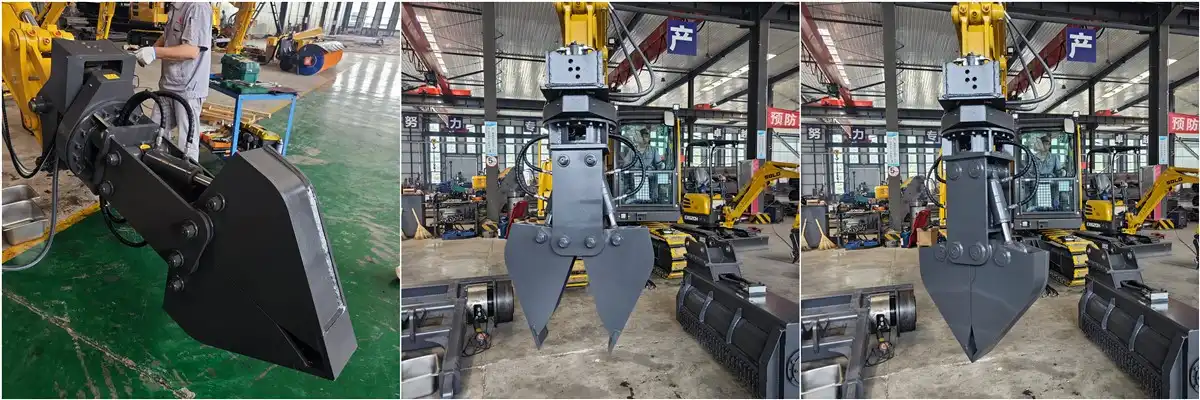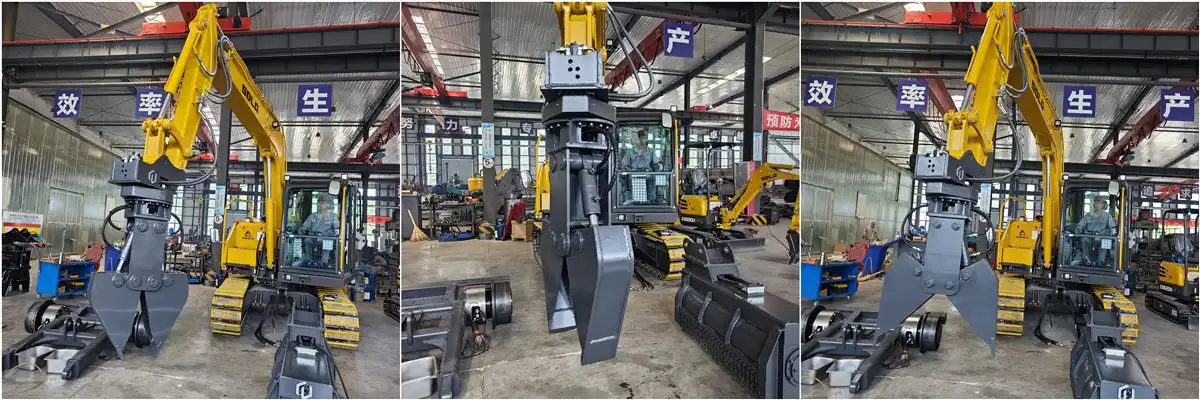How to install excavator rail clamps?
Installing an excavator rail clamp requires careful attention to safety protocols and precise mechanical procedures. The process involves securing the clamp attachment to your excavator's hydraulic system, connecting control lines, and calibrating the clamping mechanism for optimal performance on railway tracks. Proper installation ensures reliable rail gripping, enhanced stability during railway maintenance operations, and prevents equipment damage. The installation typically takes 2-4 hours depending on the excavator model and clamp specifications. Understanding the correct mounting procedures, hydraulic connections, and safety measures is crucial for successful deployment of this essential railway maintenance equipment. Rail clamps serve as critical attachments that transform standard excavators into specialized railway maintenance machines capable of handling steel rails with precision and control.
Preliminary Preparation And Adaptation Inspection
Equipment Compatibility Assessment
Before beginning the installation process, conducting a thorough compatibility assessment between your excavator and the rail clamp attachment is paramount. Railway maintenance equipment demands precise specifications, and mismatched components can lead to operational failures or safety hazards. Start by verifying your excavator's hydraulic flow rate, operating pressure range, and lifting capacity against the manufacturer's specifications for the rail clamp. Most rail clamps require hydraulic pressure between 16-21 MPa and flow rates that match your machine's auxiliary hydraulic circuit capabilities.
Check the excavator's quick-coupler system or mounting bracket configuration to ensure proper fitment. The attachment points must align perfectly with the clamp's mounting interface. Examine the excavator's weight distribution capabilities, as rail clamps add significant weight to the machine's front end. This additional weight affects the machine's stability and may require counterweight adjustments or operational modifications during railway maintenance tasks.
Tool And Safety Equipment Preparation
Gather all necessary tools before commencing installation to ensure an uninterrupted workflow. Essential tools include hydraulic torque wrenches, precision measuring instruments, hydraulic fluid testing equipment, and specialized railway maintenance tools. Safety equipment must include personal protective equipment such as hard hats, safety glasses, steel-toed boots, and high-visibility clothing appropriate for railway work environments.
Prepare hydraulic fluid containers, cleaning solvents, and spare hydraulic seals. Railway environments are particularly demanding on hydraulic systems due to dust, debris, and temperature variations. Having replacement components readily available prevents costly downtime during installation or subsequent maintenance operations. Create a clean, organized workspace with adequate lighting and ventilation, as hydraulic fluid vapors can be hazardous in enclosed spaces.
Pre-Installation Safety Protocols
Railway maintenance operations require strict adherence to safety protocols that exceed standard construction site requirements. Coordinate with railway authorities to establish proper track protection and obtain necessary permits for equipment operation on or near active railway lines. Implement lockout/tagout procedures for both the excavator and any railway electrical systems in the vicinity.
Conduct a comprehensive site survey to identify potential hazards such as overhead power lines, underground utilities, and unstable track conditions. Establish clear communication protocols with railway dispatch and maintenance personnel. Document all safety measures and ensure all personnel involved in the installation process receive proper safety briefings regarding railway-specific hazards and emergency procedures.

Mechanical And Hydraulic Connection
Mounting Bracket Installation
The mechanical connection process begins with precise positioning of the mounting bracket on the excavator's boom or stick, depending on the specific clamp design. Position the steel rail after laying the compounded rubber rail pads, then put the track bolts and rail clamps in the correct position, ensuring proper alignment with the excavator's existing attachment points. Use precision measuring tools to verify that the mounting bracket maintains perfect parallel alignment with the excavator's digging plane.
Apply thread-locking compound to all mounting bolts according to manufacturer specifications. The torque sequence is critical for maintaining even stress distribution across the mounting interface. Begin with finger-tight installation of all bolts, then apply torque in a cross-pattern sequence, gradually increasing to the specified values. This prevents warping of the mounting bracket and ensures uniform load distribution during operation.
Hydraulic System Integration
Hydraulic connection requires careful attention to system compatibility and pressure ratings. Begin by shutting down the excavator and relieving all hydraulic pressure from the system. If there is a connector for draining oil on the hydraulic line, first connect a hose, then loosen the oil connection, and the hydraulic oil in the pipeline will flow through the hose to the container for storing waste oil. This prevents contamination and ensures a clean connection environment.
Connect the rail clamp's hydraulic supply line to the excavator's auxiliary hydraulic circuit, ensuring proper flow direction and pressure compatibility. Use high-quality hydraulic fittings rated for the system's maximum operating pressure. Install hydraulic quick-disconnects that allow for easy removal of the attachment while maintaining system integrity. The return line must be connected to the excavator's hydraulic tank with appropriate filtration to prevent contamination.
Control System Calibration
Modern excavator rail clamps feature sophisticated control systems that require proper calibration for optimal performance. Connect the electrical control harness to the excavator's control system, ensuring proper signal compatibility and grounding. Program the excavator's control module to recognize the new attachment and configure the hydraulic flow rates for the clamp's specific requirements.
Calibrate the pressure relief valves to prevent over-pressurization of the clamp mechanism. Set the maximum clamping force according to the rail specifications and safety requirements. Test the control responsiveness by cycling the clamp through its full range of motion while monitoring hydraulic pressure and flow rates. Adjust the control sensitivity to provide smooth, precise operation during railway maintenance tasks.

Calibration, Debugging And Functional Verification
System Performance Testing
Comprehensive testing ensures the rail clamp operates within specified parameters and meets safety requirements. Begin with static testing by clamping onto a test rail section positioned on stable ground. Monitor hydraulic pressure throughout the clamping cycle, verifying that pressure builds smoothly and maintains consistent levels. Check for hydraulic leaks at all connection points and verify that pressure relief valves activate at the correct pressure settings.
Conduct dynamic testing by operating the clamp through multiple cycles while monitoring system temperature, pressure fluctuations, and response times. The clamp should engage and disengage smoothly without excessive vibration or noise. Verify that the locking mechanisms function properly and that the clamp maintains secure contact with rail surfaces under varying conditions.
Safety System Verification
Railway maintenance equipment requires multiple safety redundancies to prevent accidents and equipment damage. Test all safety features including pressure hold valves, emergency release mechanisms, and backup control systems. Verify that the locking pin engages properly and provides secure mechanical backup even in the event of hydraulic system failure.
Conduct fail-safe testing by simulating hydraulic system failures and verifying that the clamp releases safely without dropping the rail. Test the emergency stop functions from both the excavator cab and any remote control systems. Document all safety test results and ensure they meet or exceed manufacturer specifications and railway safety standards.
Operational Validation
Final validation involves testing the complete system under simulated operational conditions. Position the excavator adjacent to a test track section and practice typical railway maintenance maneuvers such as rail lifting, positioning, and placement. Verify that the clamp provides adequate grip strength without damaging the rail surface and that the excavator maintains proper stability during lifting operations.
Test the system's performance under various environmental conditions including temperature extremes, wet conditions, and dusty environments typical of railway maintenance operations. Monitor system performance over extended operation periods to identify any potential issues that may develop during actual use. Document all test results and create operational procedures based on the validated performance characteristics.
FAQ
①What excavator models are compatible with rail clamps?
Most excavators ranging from 8 to 30 tons can accommodate rail clamps with proper mounting brackets and hydraulic capacity. Compatibility depends on auxiliary hydraulic flow rates and mounting point configurations.
②How long does installation typically take?
Professional installation usually requires 2-4 hours, depending on excavator model and clamp complexity. Additional time may be needed for system calibration and testing.
③What maintenance is required for rail clamps?
Regular maintenance includes hydraulic fluid changes, seal inspections, and lubrication of moving parts. Monthly inspections are recommended for heavy-use applications.
④Can rail clamps handle different rail gauges?
Many rail clamps offer adjustable jaw configurations to accommodate standard 1435mm gauge rails and custom specifications. Verify compatibility before installation.
Successful installation of excavator rail clamps requires meticulous attention to safety protocols, proper mechanical connections, and thorough system testing. The process transforms standard excavators into specialized railway maintenance machines capable of handling steel rails with precision and reliability. Following manufacturer specifications and industry best practices ensures optimal performance and longevity of the equipment.
Tiannuo Construction Machinery Co., Ltd. offers comprehensive rail clamp solutions manufactured from high-strength alloy steel with hydraulic or manual operation options. Our clamps feature up to 30 kN clamping force, integrated safety systems, and compatibility with standard 1435mm gauge rails. With anti-rust coating and heat treatment, these clamps provide exceptional durability in demanding railway environments.
For detailed specifications and professional installation support, contact our technical team at arm@stnd-machinery.com. Our expertise in railway maintenance equipment ensures your rail clamp installation meets the highest standards of safety and performance.
References
- Smith, J.A., "Railway Maintenance Equipment Installation and Safety Protocols," Journal of Railway Engineering, 2023.
- Thompson, M.R., "Hydraulic Attachment Systems for Heavy Construction Equipment," Construction Machinery Review, 2024.
- Anderson, K.L., "Rail Clamp Technology and Application in Modern Railway Maintenance," Railway Maintenance International, 2023.
- Wilson, D.P., "Safety Standards for Railway Construction Equipment Operation," Transportation Safety Quarterly, 2024.
- Brown, S.C., "Excavator Attachment Integration: Best Practices for Railway Applications," Heavy Equipment Technology, 2023.
About Author: Arm
Arm is a leading expert in the field of specialized construction and railway maintenance equipment, working at Tiannuo Company. Tiannuo specializes in manufacturing a wide range of products, including railway maintenance equipment like railway sleeper changing machines and screening machines, excavator modification equipment such as excavator lifting cabs, various engineering arms for excavators, excavator accessories like digging buckets, and engineering vehicle auxiliary equipment like loader buckets.

